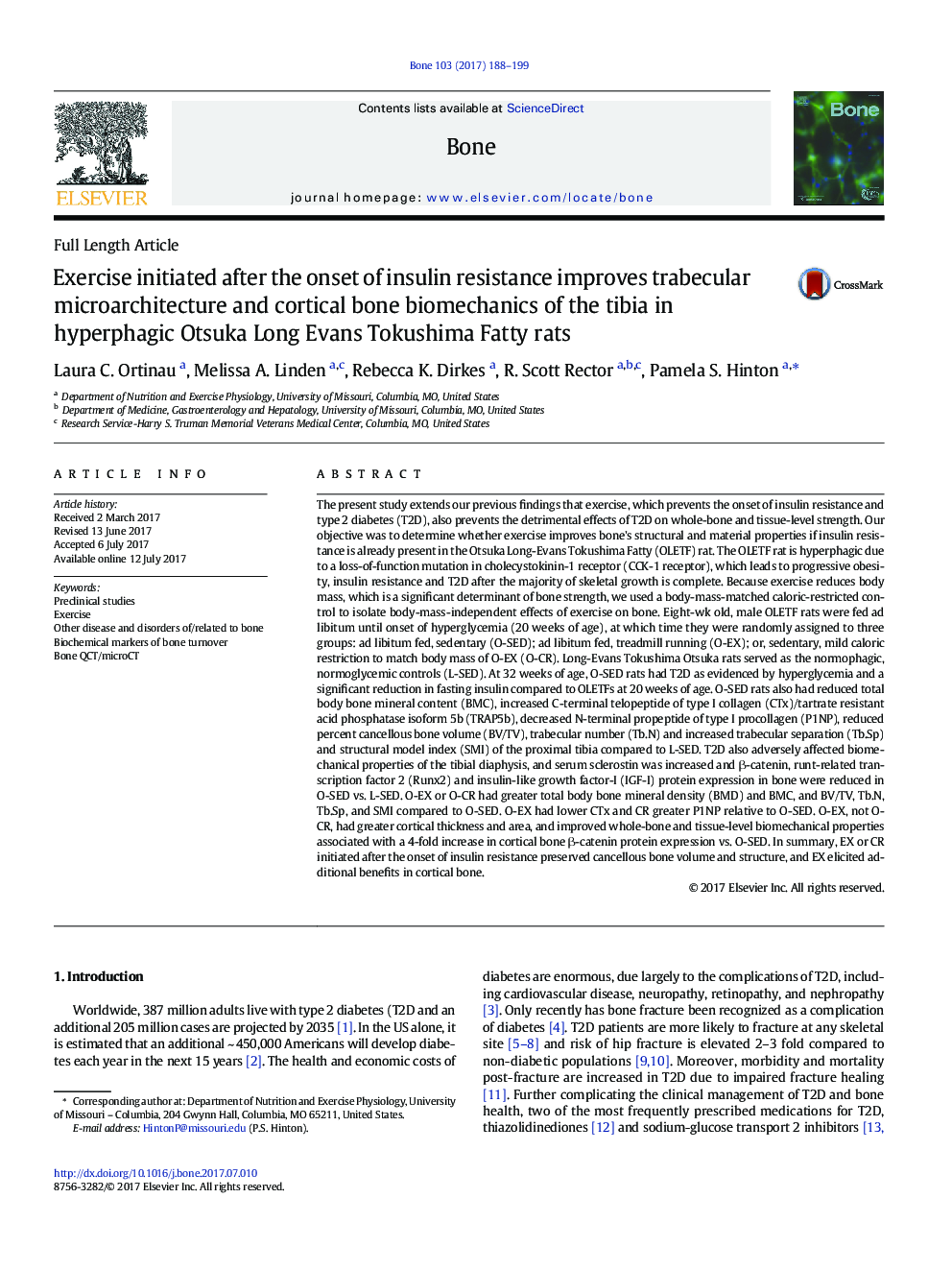| کد مقاله | کد نشریه | سال انتشار | مقاله انگلیسی | نسخه تمام متن |
|---|---|---|---|---|
| 5585271 | 1568116 | 2017 | 12 صفحه PDF | دانلود رایگان |
عنوان انگلیسی مقاله ISI
Exercise initiated after the onset of insulin resistance improves trabecular microarchitecture and cortical bone biomechanics of the tibia in hyperphagic Otsuka Long Evans Tokushima Fatty rats
دانلود مقاله + سفارش ترجمه
دانلود مقاله ISI انگلیسی
رایگان برای ایرانیان
کلمات کلیدی
موضوعات مرتبط
علوم زیستی و بیوفناوری
بیوشیمی، ژنتیک و زیست شناسی مولکولی
زیست شناسی تکاملی
پیش نمایش صفحه اول مقاله

چکیده انگلیسی
The present study extends our previous findings that exercise, which prevents the onset of insulin resistance and type 2 diabetes (T2D), also prevents the detrimental effects of T2D on whole-bone and tissue-level strength. Our objective was to determine whether exercise improves bone's structural and material properties if insulin resistance is already present in the Otsuka Long-Evans Tokushima Fatty (OLETF) rat. The OLETF rat is hyperphagic due to a loss-of-function mutation in cholecystokinin-1 receptor (CCK-1 receptor), which leads to progressive obesity, insulin resistance and T2D after the majority of skeletal growth is complete. Because exercise reduces body mass, which is a significant determinant of bone strength, we used a body-mass-matched caloric-restricted control to isolate body-mass-independent effects of exercise on bone. Eight-wk old, male OLETF rats were fed ad libitum until onset of hyperglycemia (20 weeks of age), at which time they were randomly assigned to three groups: ad libitum fed, sedentary (O-SED); ad libitum fed, treadmill running (O-EX); or, sedentary, mild caloric restriction to match body mass of O-EX (O-CR). Long-Evans Tokushima Otsuka rats served as the normophagic, normoglycemic controls (L-SED). At 32 weeks of age, O-SED rats had T2D as evidenced by hyperglycemia and a significant reduction in fasting insulin compared to OLETFs at 20 weeks of age. O-SED rats also had reduced total body bone mineral content (BMC), increased C-terminal telopeptide of type I collagen (CTx)/tartrate resistant acid phosphatase isoform 5b (TRAP5b), decreased N-terminal propeptide of type I procollagen (P1NP), reduced percent cancellous bone volume (BV/TV), trabecular number (Tb.N) and increased trabecular separation (Tb.Sp) and structural model index (SMI) of the proximal tibia compared to L-SED. T2D also adversely affected biomechanical properties of the tibial diaphysis, and serum sclerostin was increased and β-catenin, runt-related transcription factor 2 (Runx2) and insulin-like growth factor-I (IGF-I) protein expression in bone were reduced in O-SED vs. L-SED. O-EX or O-CR had greater total body bone mineral density (BMD) and BMC, and BV/TV, Tb.N, Tb.Sp, and SMI compared to O-SED. O-EX had lower CTx and CR greater P1NP relative to O-SED. O-EX, not O-CR, had greater cortical thickness and area, and improved whole-bone and tissue-level biomechanical properties associated with a 4-fold increase in cortical bone β-catenin protein expression vs. O-SED. In summary, EX or CR initiated after the onset of insulin resistance preserved cancellous bone volume and structure, and EX elicited additional benefits in cortical bone.
ناشر
Database: Elsevier - ScienceDirect (ساینس دایرکت)
Journal: Bone - Volume 103, October 2017, Pages 188-199
Journal: Bone - Volume 103, October 2017, Pages 188-199
نویسندگان
Laura C. Ortinau, Melissa A. Linden, Rebecca K. Dirkes, R. Scott Rector, Pamela S. Hinton,